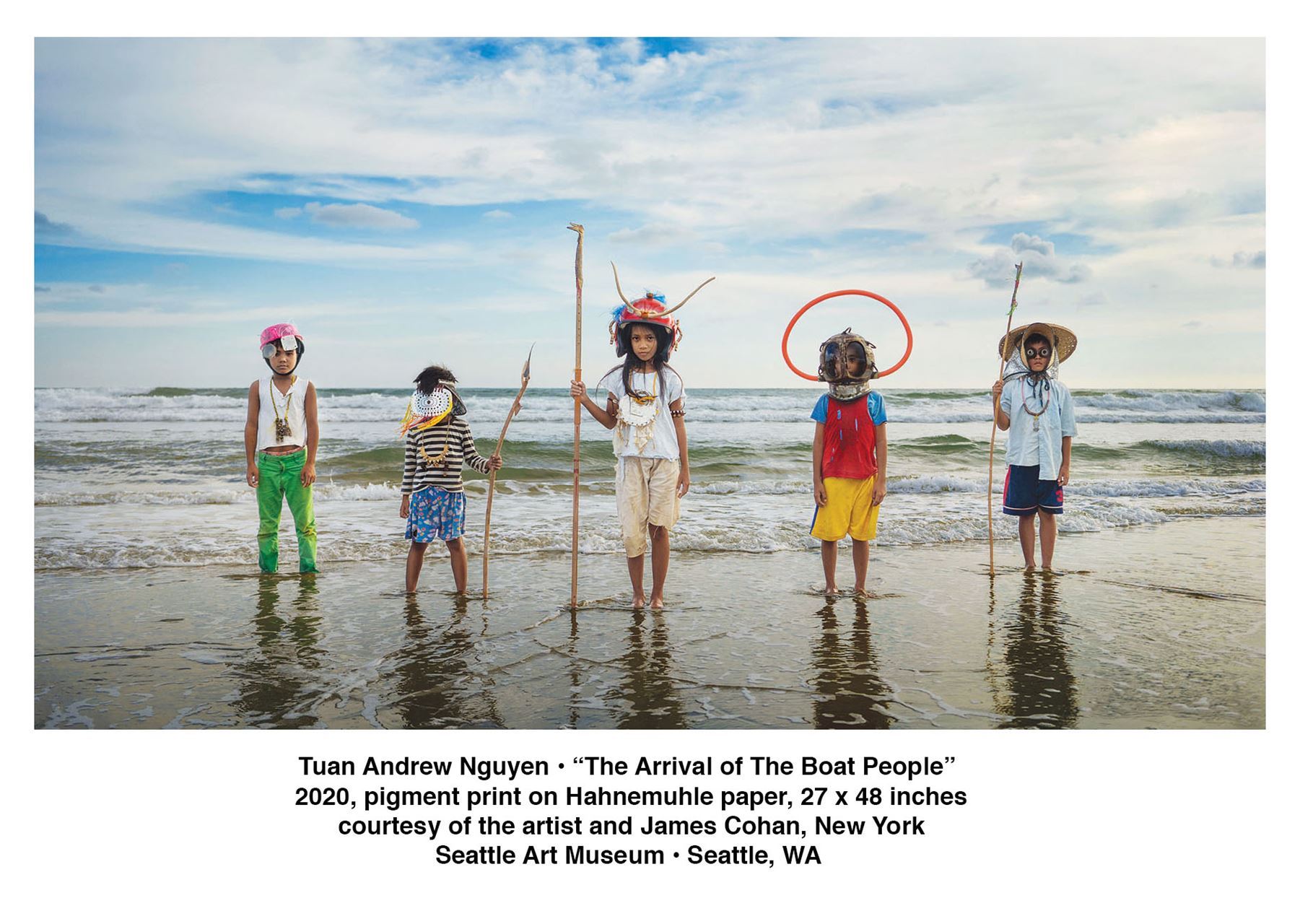 At the entrance of “Our Blue Planet,” Ken Workman, the direct descendant of Chief Seattle, welcomes us from the shores of the Duwamish River, the historic homeland of his people, now a superfund site.
At the entrance of “Our Blue Planet,” Ken Workman, the direct descendant of Chief Seattle, welcomes us from the shores of the Duwamish River, the historic homeland of his people, now a superfund site.
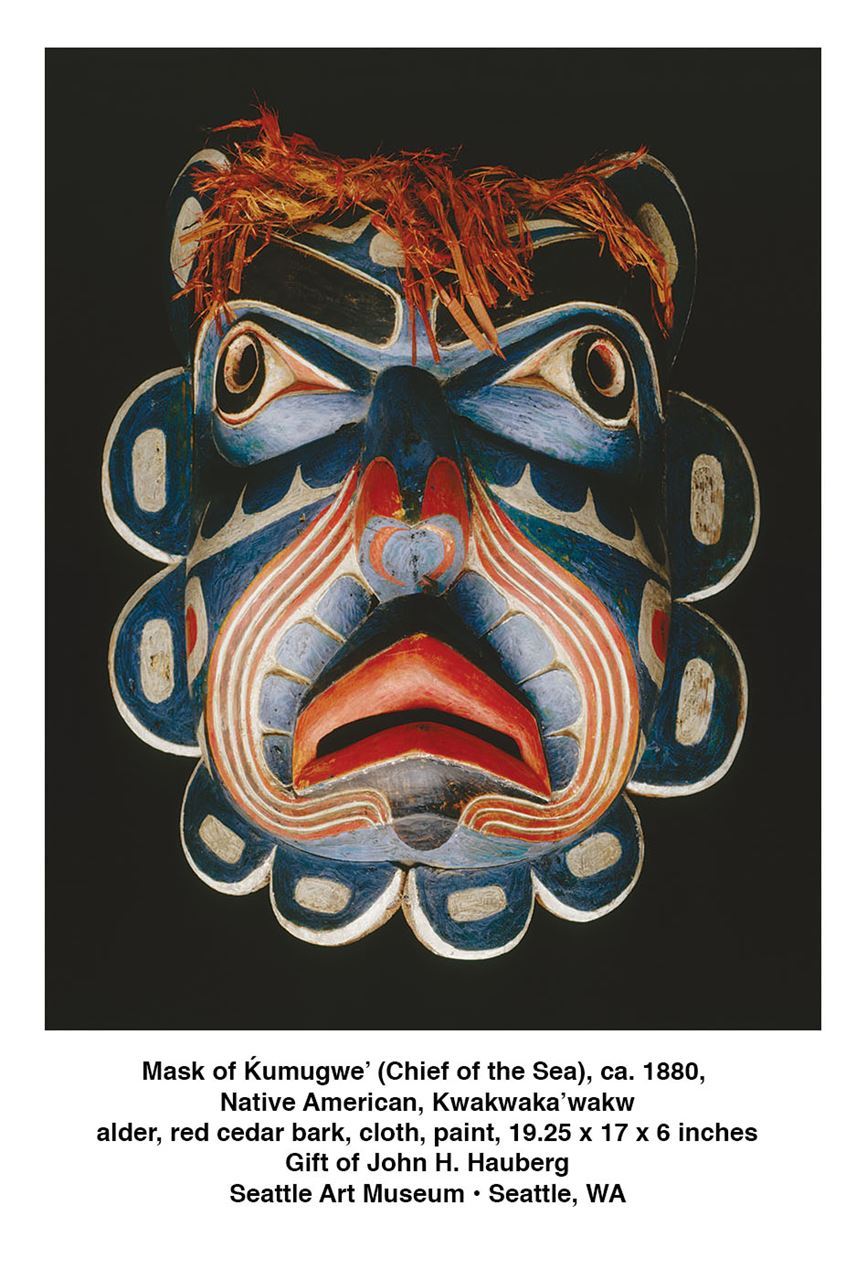 That pairing of history, water, and the present condition of the planet is one theme of “Our Blue Planet.” We next see above our heads, a long banner by Carolina Caycedo that documents the changes in a river as it goes from clean (blue) to polluted (mud colored). Nearby in Caycedo’s video, we learn from the people living on the Paranà River in Brazil, about their traditional ways, the impact of a huge dam on their lives, and their brave resistance.
That pairing of history, water, and the present condition of the planet is one theme of “Our Blue Planet.” We next see above our heads, a long banner by Carolina Caycedo that documents the changes in a river as it goes from clean (blue) to polluted (mud colored). Nearby in Caycedo’s video, we learn from the people living on the Paranà River in Brazil, about their traditional ways, the impact of a huge dam on their lives, and their brave resistance.
This landmark exhibition has ten themes and almost one hundred art works, all drawn from the museum’s own collections and local loans. Three curators collaborated on its organization, mostly remotely, during the pandemic. Pamela McClusky, Curator of African and Oceanic Art; Barbara Brotherton, Curator of Native American Art; and Natalia Di Pietrantonio, newly appointed as Assistant Curator of South Asian Art, created themes that refer to water as necessary to life, as pleasure, as law, as mythic, and as desecrated. They encompass celebration, poetry, ritual, and catastrophe. The exhibition is truly global spanning every continent.
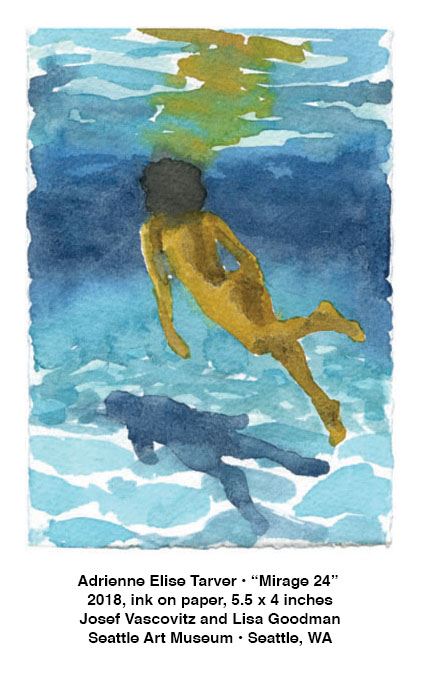
At the outset, the revival of Indigenous Canoe Journeys is honored with regalia by Danielle Morsette for the ceremonial greetings during stops on the way to the host tribe. These elegant garments are part of the theme “Rivers and Canoes that Sustain Life” which also includes striking videos of actual journeys by Tracey Rector.
The theme “Rains that Flood and Hypnotize” naturally includes a compelling photograph of a monsoon in India by Raghubir Singh of four women huddled together. In contrast, Amrita Das vividly depicts the overwhelming destruction of the 2004 Tsunami in Sri Lanka in the linear patterns of the indigenous Mithila Style.
One of my favorite themes was “Future Waters through the eyes of Women and Children.” The seemingly science fiction landscape of Dallol in Northern Ethiopia, one of the hottest and driest places on Earth, is the setting for the work of Ethiopian artist Aïda Muluneh, who reenacts the almost impossible process of getting water there. Tuan Andrew Nguyen’s video “The Boat People” imagines a future world in which children collect the detritus of what we have left behind and create rituals with them.
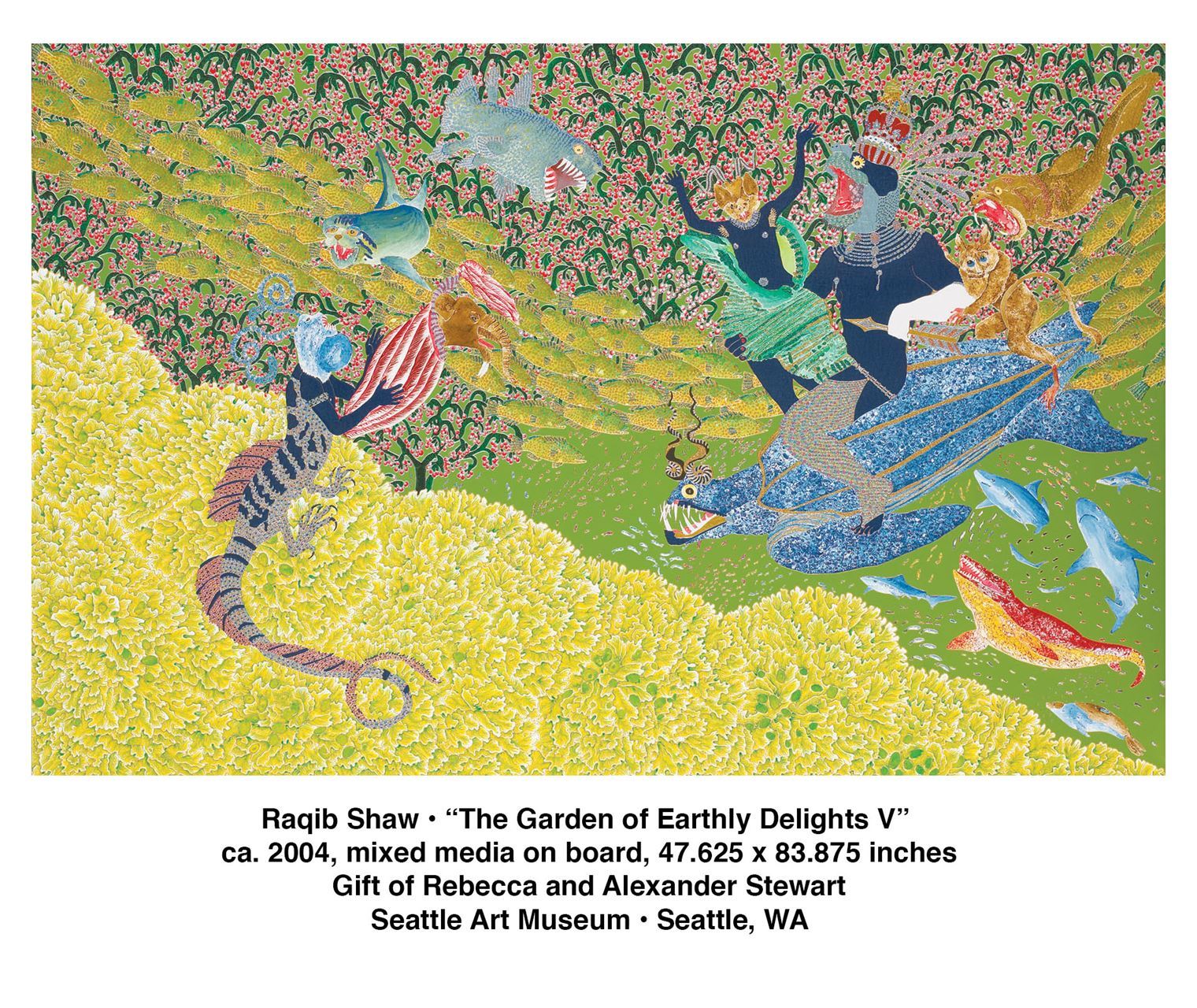 One of the strengths of Seattle Art Museum is Australian indigenous art, and as we hear daily about climate disasters there, the work by those artists takes on all the more significance. They appear throughout the exhibition culminating in the gallery “Where Water is Law in Northern Australia” with newly created works incised on found aluminum next to the more traditional bark paintings.
One of the strengths of Seattle Art Museum is Australian indigenous art, and as we hear daily about climate disasters there, the work by those artists takes on all the more significance. They appear throughout the exhibition culminating in the gallery “Where Water is Law in Northern Australia” with newly created works incised on found aluminum next to the more traditional bark paintings.
Reinstalling works from other galleries in new contexts is another surprise of the exhibition as we greet “The Mask of Ḱumugwe’(Chief of the Sea)” from the Kwakwaka’waka who presides over “Sea Creatures Who are Honored and Endangered.” Not far away is a promised gift, a dramatic bronze turtle. It is an homage to a ritual tradition as well as a reference to efforts today to preserve these turtles and other marine creatures through collaborations between scientists and Indigenous elders.
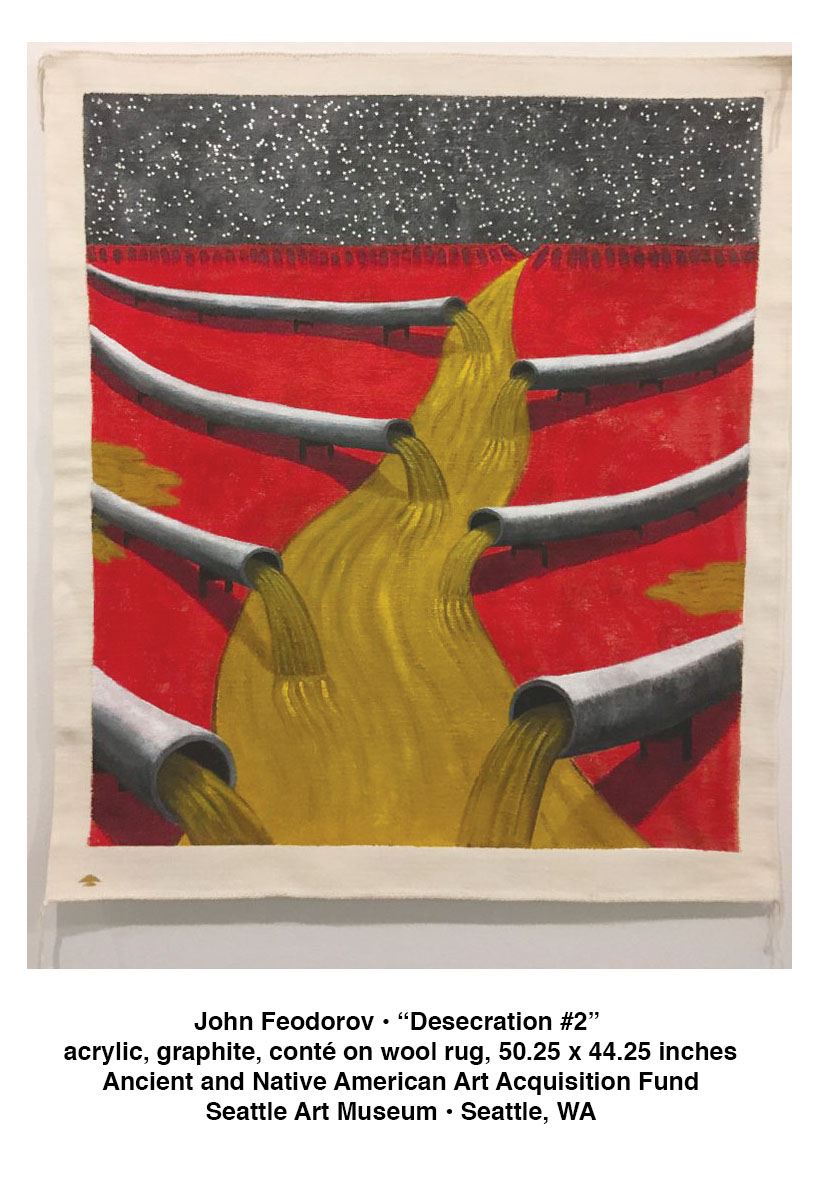 We see with new eyes in the reinstallation of Marita Dingus’s stark statement about the slave trade and Claire Partington’s surprising porcelain ensemble that goes way beyond decorative arts in “Tragic Memories of Global Trade.”
We see with new eyes in the reinstallation of Marita Dingus’s stark statement about the slave trade and Claire Partington’s surprising porcelain ensemble that goes way beyond decorative arts in “Tragic Memories of Global Trade.”
“Mythic Vision from Water’s Creation to Regulation” includes Raqib Shaw’s colorful fantasy of underwater life “Garden of Earthly Delights V” as well as references to the dangers and mysteries of the sea from ancient China to the present.
Finally “Desecration of our Troubled Waters,” speaks to our deeply troubled planet. “Desecration #2” by John Feodorov brings together the sacred and the profane in his depiction of pipelines spilling pollution into the ground of an Indigenous reservation, painted on a sacred white carpet.
Be sure to download the QR codes to listen to the artists own dramatic commentaries. I was particularly mesmerized by the video from the Torres Straits (an archipelago of 300 islands north of Australia), and La Toya Ruby Frazier, who spoke eloquently about her project on the pollution of water in Flint, Michigan.
This not to-be-missed exhibition immerses, enchants, warns, and finally, hopes to inspire us to action. A video at the end “Water Protectors,” asks artists, activists, leaders, and scientists, to answer the question “What can people do to honor and protect water?” We must all ask ourselves that question.
Susan Noyes Platt
Susan Noyes Platt writes a blog www.artandpoliticsnow.com and for local, national, and international publications.
“Our Blue Planet: Global Visions of Water” is on view until May 30, Wednesday through Sunday 10 A.M. to 5 P.M. at Seattle Art Museum, located at 1300 First Avenue in Seattle, Washington. Visit www.SeattleArtMuseum.org for more information.